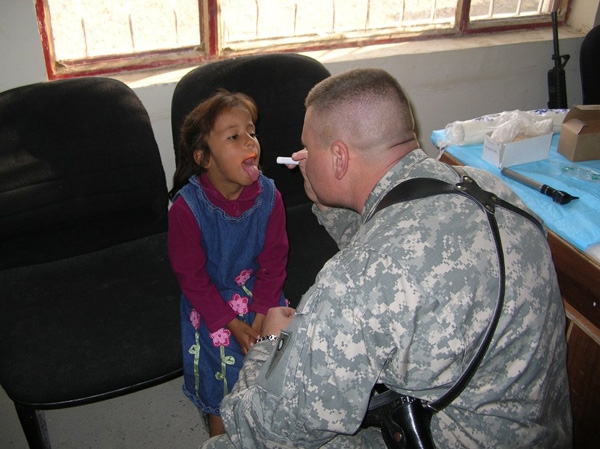
This is the second in a series of articles from the Deputy Assistant Secretary of the Army (DASA) for Services.
[raw][image align=”right” caption=”Medical-related services make up one of the DASA for Services’ six portfolios, Services acquisition portfolio groups provide the structure needed to effectively manage specific mission requirements and to achieve the Army’s goal of a disciplined and rigorous services acquisition process. (U.S. Army photo.)” linkto=”/web/wp-content/uploads/army.mil-2007-03-01-150340.jpg” linktype=”image”]”/web/wp-content/uploads/army.mil-2007-03-01-150340.jpg” height=”167″ width=”246″[/image][/raw]On Sept. 28, the Secretary of the Army approved the “Optimization of Army Services Acquisition Implementation Plan.” The plan describes the roles and responsibilities of HQDA and subordinate organization leaders, the processes they will use to acquire services, and the governance and review mechanisms to improve visibility and accountability of the requiring activities. Most important is that the plan launches a new way of doing business in services acquisition. Integral to the approach is a new governance structure that includes portfolio management and processes designed to identify, track, and monitor projected savings. This installment in the three-part series on services acquisition describes the governance structure.
The structure is organized in accordance with the taxonomy directed by the Under Secretary of Defense for Acquisition, Technology, and Logistics. The six portfolio groups are aligned with the taxonomy as depicted in Figure 1. The Assistant Secretary of the Army for Acquisition, Technology, and Logistics (ASAALT) is the Army Acquisition Executive and senior official responsible for acquiring services for the Army. The Office of the Deputy Assistant Secretary of the Army for Services (DASA(S)) has been established within ASAALT to develop Army services acquisition policy and provide oversight of the services governance concept. The DASA(S) is designated as the Army’s Senior Services Manager, as required by DOD policy.
[raw][image align=”left” caption=”Figure 1: Mandated Portfolio Groups” linkto=”/web/wp-content/uploads/Figure-1-Mandated-Portfolios.png” linktype=”image”]”/web/wp-content/uploads/Figure-1-Mandated-Portfolios.png” height=”167″ width=”246″[/image][/raw]Services acquisition portfolio groups provide the structure needed to effectively manage specific mission requirements.
Portfolio management is essential to achieving the Army’s goal of a disciplined and rigorous services acquisition process. Figure 2 depicts both the vertical and horizontal axes of the portfolio management governance structure and the relationships between the Army commands and the Portfolio Managers (PfMs). Portfolio management is led by the DASA(S) and executed by commands to provide management and accountability at all levels across the Army.
In the vertical axis, the commander or staff principal is responsible for managing resources, delivering services, and achieving savings. Commanders are responsible for all phases of the services life cycle and should treat service acquisitions as programs, not contracts.
[raw][image align=”right” caption=”Figure 2: Services Governance Structure” linkto=”/web/wp-content/uploads/Figure-2-Services-Governance-Structure.png” linktype=”image”]”/web/wp-content/uploads/Figure-2-Services-Governance-Structure.png” height=”167″ width=”246″[/image][/raw]
Commanders will appoint a Command Services Executive (CSE), at the general officer or Senior Executive Service (SES) level, as a single focal point to manage all service acquisitions for the command. Commands must have an internal process for managing service acquisitions that meet minimum standards, including the use of multifunctional integrated process teams. The horizontal axis is led by the PfMs—full-time senior civilians in five designated commands (U.S. Army Materiel Command, Installation Management Command, Cyber Command, Medical Command, and Training and Doctrine Command) and one in the office of the DASA(S). The five commands are mission-organized and have expertise in specific portfolio groups. Because no single command is mission-oriented to oversee the knowledge-based services (KBS) portfolio group, the DASA(S) retains this portfolio for management. However, three of the major portfolios within KBS—logistics management, engineering management, and education and training—are aligned with the core competency of identifiable commands.
The PfM provides Armywide coordination of services acquisition for its portfolio under the guidance and direction of the DASA(S). In addition, the PfM recommends strategic sourcing solutions and best practices; provides lessons learned; assists in market research activities; maintains tools and templates, such as examples of performance work statements; and supports the conduct of periodic spending analyses to gain insight and enable fact-based strategic decisions. PfMs help commands implement improved management and effectiveness of services acquisition. They promote better buying power initiatives and compliance with DOD Instruction 5000.02, Enclosure 9, Acquisition of Services; Army Regulation 70-13, Management and Oversight of Service Acquisitions; and ASAALT guidance.
Portfolio Coordinators are assigned to the DASA(S) to provide HQDA staff oversight and coordination of service acquisitions within assigned portfolios. They assist the DASA(S), CSEs, and PfMs in implementing services acquisition governance and policy, resolve services acquisition governance issues within and across commands, and plan for Annual Requirements Execution Reviews of services acquisition portfolios.
[raw][image align=”left” caption=”Figure 3: Services Acquisition Approval Process” linkto=”/web/wp-content/uploads/Figure-3-Services-Acquisition-Approval-Process.png” linktype=”image”]”/web/wp-content/uploads/Figure-3-Services-Acquisition-Approval-Process.png” height=”167″ width=”246″[/image][/raw]
Another important aspect of services acquisition governance is the process for approval of acquisition strategies for services procurement. Services acquisition strategies of greater dollar value than the simplified acquisition threshold, but less than $250 million, will continue to be reviewed and approved at the local agency level, in accordance with current Army Federal Acquisition Regulation Supplement (AFARS) guidance. The DASA(S) receives copies of acquisition strategies valued between $10 million and $250 million, to maintain visibility. Acquisition strategies for service acquisitions valued at $250 million to $500 million will be approved by the DASA(S).Those service acquisitions valued at $500 million or more will continue to follow the current AFARS. Figure 3 shows the services acquisition approval process.
The “Optimization of Army Services Acquisition Implementation Plan” establishes a new Army-wide services governance structure with day-to-day oversight by the DASA(S). As an integral part of the plan, the portfolio management concept promotes efficiency and cross-command synergies in buying services. This “new way of doing business” is expected to secure better buying power for the Army in services acquisition.
Next: Reporting and life-cycle surveillance.
For more information on the DASA for Services, visit https://www.alt.army.mil/portal/page/portal/oasaalt/OASA(ALT)%20Services%20(SAAL-ZV)%20and%20DASA-S.
[list type=”arrow”]
- DASA for Services Staff







